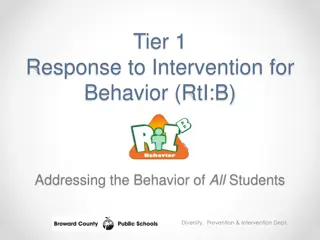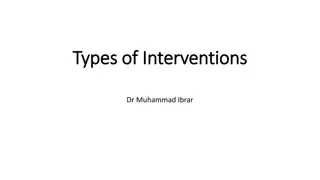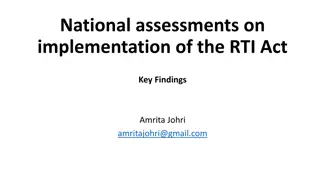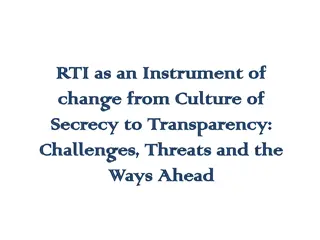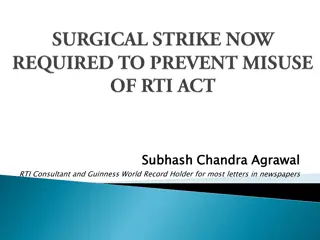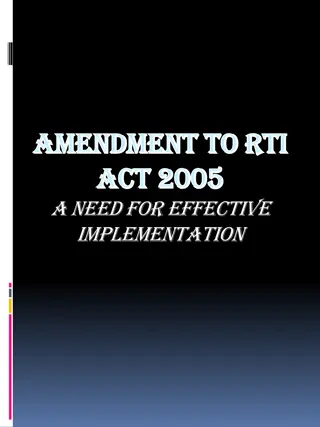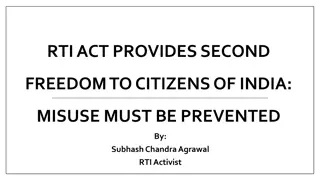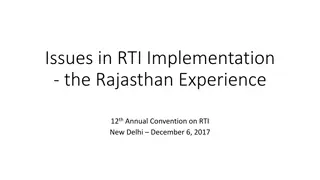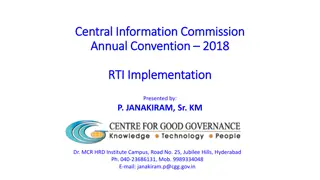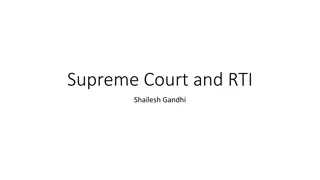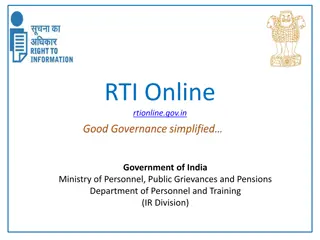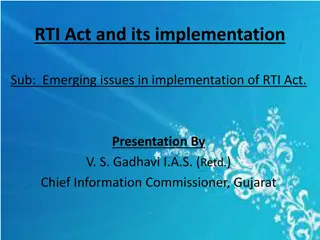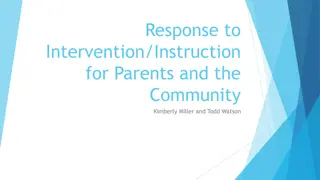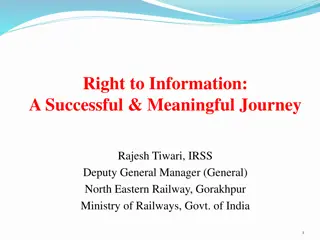Understanding Tier 3 Intensive Intervention in RTI Systems
This content delves into the critical features of Tier 3 interventions within Response to Intervention (RTI) frameworks. It covers the objectives of Tier 3 systems, designing and implementing interventions, problem-solving processes, essential components of RTI, evidence standards for interventions, and the importance of evidence-based practices to support students struggling academically. The focus is on maximizing student achievement and behavior management through targeted interventions.
Download Presentation

Please find below an Image/Link to download the presentation.
The content on the website is provided AS IS for your information and personal use only. It may not be sold, licensed, or shared on other websites without obtaining consent from the author. Download presentation by click this link. If you encounter any issues during the download, it is possible that the publisher has removed the file from their server.
E N D
Presentation Transcript
Module 10 Tier 3: Intensive Intervention
Module 10 Objectives Participants will be able to: Explain the critical features of an RTI Tier 3 system. Describe the essential elements of Tier 3 interventions. Describe the five steps for designing and implementing Tier 3 intensive interventions. Apply the problem-solving process to individual data- based decision making at Tier 3. 2
Think-Pair-Share Think of a time when you worked with a child who continued to struggle despite your best efforts. How did you respond? What supports were available? Pair with your partner. Share your experiences. Discuss how they are similar and different. Discuss 3
Essential Components of RTI RTI integrates assessment and intervention within a schoolwide, multilevel prevention system (i.e., multi-tiered system of support, or MTSS) to maximize student achievement and reduce behavior problems. 4
Tier 3 Intensive Intervention 6
Varying Evidence Standards Research-Based Evidence-Based Recommended for Tier I across subjects Components have been researched and found to be generally effective Curriculum materials have not been rigorously evaluated as a package Recommended for Tier 2 and Tier 3 Materials evaluated using rigorous research design Evidence of positive effects for students who received the intervention 8
Interventions Within an RTI Framework Using interventions that have a proven track record increases the probability of positive outcomes for students. Interventions Must Be Evidence- Based (Brown-Chidsey & Steege, 2005, p. 8) 9
What Is Intensive Intervention? Intensive intervention is designed to address severe and persistent learning or behavioral difficulties Driven by data Characterized by increased intensity (e.g., smaller group, expanded time) Provided with individualized academic instruction and/or behavioral supports 11
Who Needs Intensive Intervention? Students with very low academic achievement and/or high-intensity or high-frequency behavior problems (may be with disabilities) Students in a tiered intervention program who have not responded to Tier 2 intervention(s) delivered with fidelity Students with disabilities who are not making adequate progress in their current instructional program 12
Essential Tier 3 Criteria More intensive than Tier 2 intervention(s) Adapted to address individual student needs in a number of ways (e.g., increased duration or frequency, change in interventionist, decreased group size, change in instructional delivery, and change in type of intervention) A consistent process based on student data 13
Essential Tier 3 Criteria Led by well-trained staff, experienced in individualizing instruction based on student data Students can be identified for Tier 3 supports either through universal screeners or nonresponse to an evidence-based intervention The advantage of using a universal screener is that students do not have to wait to fail at Tiers 1 and 2 14
Distinction Between Tiers Tier 2 Tier 3 Focus Students considered at-risk determined by universal screening, progress monitoring data, and additional validated measures of student performance Classroom teacher or trained, skilled, and knowledgeable school personnel Preference in general education classroom Students not responding appropriately to Tier I core instruction and Tier II interventions Interventionist Highly trained, skilled, and knowledgeable school or specialized personnel Outside of general education classroom Setting Grouping Small, homogeneous grouping (1:3 - 1:5) Small, homogeneous grouping (1:1 - 1:3) 15
Distinction Between Tiers Tier 2 Tier 3 Curriculum Supplemental, evidence-based interventions designed to address skill deficits of students; supports core instruction Supplemental, customized, intensive, systematic, evidence-based instruction that targets areas of greatest need; supplements core instruction 30-60 minutes; five times per week consistent with the intervention research Combination of informal and formal measures to inform instruction, identify specific skill deficits, and determine interception relative to core area Once per week to examine rate and level of performance for the purpose of determining student response to intensive intervention Time 20-30 minutes; 3 to 4 times a week consistent with the intervention research Combination of informal and formal measures to inform instruction and determine response to intervention, and use diagnostic assessment to identify specific skill deficits Every two weeks examine rate and level of performance for the purpose of determining student response to supplemental instruction Assessment Progress Monitoring 16
Fidelity of Implementation Tier 2 Tier 3 Degree to which the program is implemented the way it was intended by the program developer Degree to which the program is implemented the way it was designed or adapted based on data and fidelity to the Tier 3 data decision-making process (Gersten et al., 2005; Mellard & Johnson, 2007; Sanetti & Kratochwill, 2009) 17
Self-Evaluation of Tier 3 System Workbook Activity 18
Elements of Tier 3 Intensive Intervention 19
Essential Characteristics of an Effective Intervention Targeted: The more targeted the intervention, the more likely it will work Systematic: A systematic process is needed to identify each student who needs specific intervention Research based: Research or evidence should support the instructional practices or intervention Administered by a trained professional Timely: Ensure the process of identification does not require students to fail too long before receiving intervention Directive: The intervention must be a requirement for the student to attend RTI at Work, Solutions Tree, 2018 20
Essential Characteristics of an Effective Intervention Activity Workbook 21
Scenario Characteristic Research Based 1. The 9th-grade English teachers discuss evidence-based instructional practices that proved to be effective while teaching the specific skills and essential standards during the school year. This information is discussed with the Critical Reading teachers. 2. The high school identifies the teachers who are most qualified to teach Critical Reading and encourages them to teach the school course. Trained 3. At the start of the school year, the school assigns students to the Critical Reading course and to a grade-level English class. Taking both classes concurrently allows the Critical Reading teachers to provide students with the needed essential skills in order to be successful in their grade-level English class. Directive 4. Using multiple data points (course proficiency, grade-level and state assessments, attendance, etc.), teachers place students in a Critical Reading course. The Critical Reading teachers collaborate to determine the specific skills students must learn to master the essential 9th- grade English standards. Targeted 5. The school decides to make Critical Reading a year-long course in which students take concurrently with their grade-level English class. This approach allows teachers to create data- based individualized plans and prepares students for immediate success. Timely 6. The Critical Reading team provides the 9th-grade English teachers with a list of the identified skills and essential standards. At the end of the year, the 9th-grade English teachers identify students who would benefit from the extra teaching and practice on the specific skills. Systematic Workbook Activity 22
Elements of Tier 3: Data-Based Individualization (DBI) 1. Tier 2 intervention program, delivered with greater intensity 2. Progress monitor 3. Informal diagnostic assessment 4. Adaptation 5. Continue progress monitoring, with adaptations occurring whenever needed to ensure adequate progress Workbook 23
Step 1: Validated Intervention Program Start with a standardized Tier 2 program Progress monitor to evaluate the student s response to the Tier 2 intervention Adequate Response? Continue Tier 2 support Move to less intensive support No intensive intervention needed Poor or No Response? Consider intensive intervention Intensify instruction Increase progress monitoring Workbook 24
Resources for Evaluating Evidence Base Tier 3 Interventions NCII What Works Clearinghouse Best Evidence Encyclopedia Interventions Tools Chart 25
Step 2: Progress Monitor Staff regularly collect and analyze progress monitoring data to determine if the student is responding to the validated intervention Does the tool meet technical standards for progress monitoring and match the desired academic or behavioral outcome? Were data collected regularly and with a consistent approach? Were progress data graphed? Was the goal set using a validated approach? Was the intervention effective for most students? 26
Step 3: Informal Diagnostic Assessments Data that may be used to identify a student s specific skill deficits and strengths Examples: Standardized measures Error analysis of progress monitoring data Student work samples Behavior rating forms Discuss 27
Step 4: Intervention Adaptation The hypothesis, along with educator expertise, is used to develop an individual student plan for modifying or adapting the intervention to better meet the student s individual needs Does the adaptation address the hypothesis? Does the plan address both academic and behavioral concerns when needed? Are procedures in place for implementing and monitoring the adapted intervention? Are only a few adaptations made at one time? 28
Step 5: Progress Monitor Did the Change Work? Continue to collect, graph, and analyze progress monitoring data to determine if the student is responding to the adapted intervention Are data collected according to the plan? Does the graph indicate when adaptations were made? 29
Suggested Duration of Intensive Intervention Consider: The size of the achievement gap with Tier 1 instruction Age of student(s) Number of sessions * Research on the recommended number of sessions varies, but plan for at least 8 16 weeks, or even longer 30
Suggested Length and Frequency of Intensive Intervention Consider: How far the student is below grade level The length and frequency of the previous interventions The complexity of the learning tasks Student stamina and attention span * Evidence suggests that students with intensive needs may benefit from 60 120 minutes of intervention per day 31
Student Intervention Team Purpose To coordinate the school s efforts to meet the needs of individual students requiring intensive support Determine the specific learning deficit(s) of each student in need of intensive support Diagnose the cause(s) of the student s struggles in Tier 1/Tier 2 and determine the most appropriate intervention(s) to address student needs Monitor the student's progress to see if interventions achieve the desired outcomes and revise when they do not achieve the desired outcomes Determine when special education identification is appropriate 33
Student Intervention Team Responsibilities Action 1: Diagnose, target, prioritize, and monitor intensive interventions Action 2: Ensure proper intervention intensity Action 3: Determine if and when special education is needed and justifiable RTI at Work, Solutions Tree, 2018 34
Action 1: Target, Prioritize, and Monitor Although students that need intensive intervention may lack the same foundational skills, it is not always for the same reasons Diverse group of experts Develop norms RTI at Work, Solutions Tree, 2018 35
Action 2: Ensure Proper Intervention Intensity Students that require intensive intervention need the most effective intervention to close their achievement gap Intensive intervention is not only for students that receive special education services Interventions should be intensive enough for students to have an opportunity to catch up There are several ways to intensify an intervention that is already occurring, both in a qualitative and quantitative way RTI at Work, Solutions Tree, 2018 36
Try Quantitative Adaptations First Increase intervention frequency, length of sessions, or duration Decrease group size Decrease heterogeneity of the intervention group Note: In many cases, quantitative adaptations may be necessary, but not sufficient, to facilitate progress for students with intensive needs NCII, 2014 37
Consider Qualitative Changes Second Change instruction based on learner characteristics Increase skill level of interventionist Change delivery method of content Change how students respond Provide additional adult feedback and error correction Increase frequency/specificity of retention checks Change part or all of an intervention program 38
Ensuring Proper Intensity Workbook Activity 39
Action 3: Determining Special Education Eligibility RTI at Work, Solution Tree, 2018 41
Building a Student Intervention Team Primarily focuses on the individual needs of the most at- risk students Team members with a diverse level of expertise RTI at Work, Solution Tree, 2018 42
Student Intervention Team Recommended Members: Administrator Specialists ELA Mathematics ELL Behavior Speech and language pathologist Special education teacher Psychologist Community-related personnel (counselor/social worker) 43
Developing a Student Intervention Team Take a moment to consider who is on your Student Intervention Team. If you don t yet have a team, who in your school should be on your team? Use these questions to guide the process of establishing a team: Who in your school is on this team? What is your understanding of the purpose of the Student Intervention Team in supporting RTI? What roles and responsibilities does this team have or should this team have? Activity Workbook 44
Tier 3 Data-Based Decision Making Case Study 45
Connecting DBDM to DBI Discuss 46
Tier 2 DBDM Problem-Solving Process Step 1. What is the problem? Classroom and screening data indicate that Jane is at risk for reading difficulties. Although she is a third grader, she is reading at an early second-grade level. Step 2. Why is this happening? The grade-level team reviewed classroom data and hypothesized she lacks appropriate phonological awareness, phonics, and fluency skills. 47
What Should Be Done? Group size: five students Session length: 20 minutes per session Frequency: five sessions per week Program duration: 12 weeks Instructional content and delivery: explicit instruction covering all components laid out in the instruction manual 48
What Should Be Done? Progress Monitoring Plan Tool: Passage Reading Fluency (PRF) Frequency: Weekly Review: Monthly Goal: Based on national norm growth rate Workbook 49




